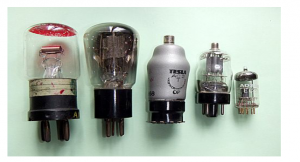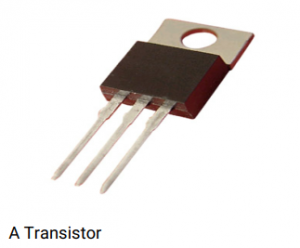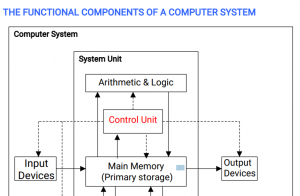INFORMATION COMMUNICATION TECHNOLOGY
DEFINITION OF TERMS
i) Computer
A computer is an electronic device that accepts and processes data into information and under
the control of instructions stored in its own memory and output or store the results for future use.
NB: An electronic device is a device that depends on the principles of electronics and uses the
manipulation of electron flow for its operation.
ii) Data
Data are raw, unprocessed and unorganized (unstructured) facts and figures that are
relatively meaningless to the user. E.g. number of hours worked by an employee.
iii) Information
Information is derived from data. This is data that is processed, organized/structured
and presented in a given context so as to make it useful. e.g., multiplying the hours
worked by the hourly rate to get each employee’s gross earning. Information is an
important component in decision making.
For example from a students test scores, the following information can be derived:
a) Class’ average score
b) Most improved student
c) Median Score etc.
USES OF INFORMATION
(a) Decision-making
When managers are ready to make choices (decisions) they need good, accurate and up-todate information. If they act without relevant information it could lead to disaster, and failure.
(b) Monitoring and control
Businesses will compare actual performance against its predicted (budgeted) performance.
Then they will act upon it.
iv) Information Communication Technology/Technologies (ICT)
ICT is an umbrella term that covers any software or hardware product that can store,
retrieve, manipulate, transmit or receive information electronically in a digital form.
Examples include personal computers, digital television, email, robots, radio, cellular
phones and networking hardware.
For our study, we are concerned with computer (hardware and software) and
telecommunications technology (data, image, and voice networks).
v) Information System (IS)
An Information System (IS) is a combination of hardware, software, personnel, data and
procedures that interact to support and improve day-to-day operations in an organization.
These elements of an Information System are also known as the components of an
Information System.
Characteristics of High Quality Data
The Audit Commission has identified six key characteristics of good quality data.
a) Accuracy
Data should be sufficiently accurate for the intended use and should be captured only once,
although it may have multiple uses. Data should be captured at the point of activity.
b) Validity
Data should be recorded and used in compliance with relevant requirements, including the
correct application of any rules or definitions. This will ensure consistency between periods
and with similar organizations, measuring what is intended to be measured.
c) Timeliness
Data should be captured as quickly as possible after the event or activity and must be available
for the intended use within a reasonable time period. Data must be available quickly and
frequently enough to support information needs and to influence service or management
decisions.
d) Relevance
Data captured should be relevant to the purposes for which it is to be used. This will require a
periodic review of requirements to reflect changing needs.
e) Completeness
Data requirements should be clearly specified based on the information needs of the
organization and data collection processes matched to these requirements.
f) Uniqueness
In order to add value to an organization, information must be unique and distinctive.
A BRIEF COMPUTER HISTORY
The abacus, which emerged about 5,000 years ago in Asia Minor and is still in use today,
may be considered the first computer. This device allows users to make computations
using a system of sliding beads arranged on a rack; it was simply a counting device

The Abacus
It took long for the next significant advance in computing devices to emerge. In 1 642,
Blaise Pascal (1 623-1 662), the 1 8-year-old son of a French tax collector, invented what
he called a numerical wheel calculator to help his father with his duties but which used
eight movable dials to add sums up. It was not until the 1 940s that the electronic
computers emerged.
In the 1 820s, Charles Babbage designed the ‘Difference Engine’, a machine which could
perform mathematical calculations. A six-wheeled model was initially constructed and
demonstrated to a number of audiences. He also worked on another invention, the more
complex Analytical Engine, a revolutionary device which was intended to be able to
perform any arithmetical calculation using punched cards that would deliver the
instructions, as well as a memory unit to store numbers and many other fundamental
components of today’s computers. Lady Ada produced programs to be used by the
analytical machine. She is claimed to be possibly the first programmer.
Five Generations of Modern Computers
Modern computers can be classified into five generations.
First generation: 1 946-1 959.
First generation of computers started with using vacuum tubes as the basic
components for memory and circuitry for CPU (Central Processing Unit). These tubes
like electric bulbs produced a lot of heat and were prone to frequent fusing of the
installations, therefore, were very expensive and could be afforded only by very large
organizations. The Electronic Numerical Integrator and Computer (ENIAC) was
announced in 1 946. It cost almost $500,000 (approximately $6,000,000 today). The
computer contained 1 7,468 vacuum tubes and consumed 1 50 kW of electricity.
Another example of computers in this generation was the UNIVersal Automatic Computer I
(UNIVAC) which used 5200 vacuum tubes and weighed 1 3 metric tons. It consumed 1 25
kW, and could perform about 1 ,905 operations per second.

Vacuum Tubes
In this generation mainly batch processing of data was done. In this generation
Punched cards, Paper tape, Magnetic tape Input & Output device were used. It is said
that this computer weighed 30 tons, and had 1 8,000 vacuum tubes which were used for
processing. When this computer was turned on for the first time lights dimmed in
sections of Philadelphia. Computers of this generation could only perform a single task
at a time, and they had no operating system.
NB: Batch processing- Executing a series of non-interactive jobs all at one time.
Second generation: 1 959-1 965.
Computers in this generation using the transistor were cheaper, consumed less power,
more compact in size, more reliable and faster than the first generation machines
made of vacuum tubes. In this generation, magnetic cores were used as primary
memory and magnetic tape and magnetic disks as secondary storage devices

A Transistor
In this generation assembly languages and high level programming languages like
FORTRAN and COBOL were used. Examples of computers in this generation include IBM
300 series and the ATLAS.
NB: A transistor is a semiconductor device used to amplify and switch electronic signals and
electrical power.
The difference between a transistor and a vacuum tube is that a transistor uses a sandwich of
silicon instead of tube filled with gas to do the switching. Silicon falls into a family of elements that
are neither conductor nor insulator; they’re called semiconductors. This type of element will be
either a conductor or an insulator depending on some condition. In the case of transistors, an
electrical current will cause the silicon to be a conductor.
Third Generation: 1 965-1 971 .
The third generation of computers is marked by the use of Integrated Circuits (IC’s) in
place of transistors. A single I.C has many transistors, resistors and capacitors along
with the associated circuitry. The I.C was invented by Jack Kilby. This development
made computers smaller in size, reliable and efficient.
In this generation Remote processing, Time-sharing, Real-time, Multi-programming
Operating System were used. High level language (FORTRAN-II TO IV, COBOL, PASCAL
PL/1 , BASIC, ALGOL-68 etc.) were used during this generation
NB:
o A resistor is a passive two-terminal electrical component that implements electrical
resistance as a circuit element.
o A capac
itor (originally known as a condenser) is a passive two-terminal electrical
component used to store energy electrostatically in an electric field.
Fourth Generation: 1 971 -1 980.
The fourth generation of computers is marked by the use of Very Large Scale
Integrated (VLSI) circuits. VLSI circuits having about 5000 transistors and other circuit
elements and their associated circuits on a single chip made it possible to have
microcomputers of fourth generation. Fourth Generation computers became more
powerful, compact, reliable, and affordable. As a result, it gave rise to personal
computer (PC) revolution.
In this generation Time sharing, Real time, Networks, Distributed Operating System were
used. All the High level languages like C and C++, DBASE etc. were used in this
generation
Fifth Generation: 1 980-todate.
In the fifth generation, the VLSI technology became ULSI (Ultra Large Scale Integration)
technology, resulting in the production of microprocessor chips having ten million
electronic components or more.
This generation is based on parallel processing hardware and AI (Artificial Intelligence)
software.
AI is an emerging branch in computer science, which interprets means and method of
making computers think like human beings. All the Higher level languages like C and
C++, Java, .Net etc. are used in this generation
THE TREND IN THE COMPUTER’S TECHNOLOGICAL REVOLUTION
Continual decrease in computer size
Improved speed and power of processing
Decrease in computer’s power consumption and its related facilities cost
Number of components per circuit (IC) greatly increased.
ADVANTAGES OF USING COMPUTERS
Processing capability/Speed – Computers have higher processing speeds than other
means of processing, measured as number of instructions executed per second.
Accuracy – Computers are not prone to errors. So long as the programs are correct, they
will always give correct output. A computer is designed in such a way that many of the
inaccuracies, which could arise due to the malfunctioning of the equipment, are detected
and their consequences avoided in a way, which is completely transparent to the user.
Consistency – Given the same data and the same instructions computers will produce
exactly the same answer every time that particular process is repeated.
Reliability – Computer systems are built with fault tolerance features, meaning that failure
of one of the components does not necessarily lead to failure of the whole system.
Memory capability – A computer has the ability to store and access large volumes of data.
Computer can operate in risky environments e.g. volcanic sites, lethal chemical plants,
where it’s risky for humans to operate.
Computers help to reduce paper work significantly.
Computers can work continuously without getting bored or tired.
Helps to cut on wage bills by reducing manpower.
DISADVANTAGES OF USING COMPUTERS
Initial cost of installation is high
Can result to retrenchment of staff
Computerization projects are not always cost-effective
In case the computers break down or malfunction, it might be extremely difficult to revert
back to the old manual system. For this reason, stand by procedures are necessary, but
expensive.
Can compromise security of data stored or being transmitted.
Computerization leads to cyber-crime e.g. pornography etc
They present a health hazard for example eye strain, trigger-finger syndrome and addiction
Due to the rapid change in the computer technology, the computer and related facilities
can become outdated very fast, hence posing a risk of capital loss and cost of upgrading.
CLASSIFICATION OF COMPUTERS
Computers can be classified in different ways as shown below:
Classification by size and capability
a) Supercomputers. The largest and most powerful. Used to process large amounts of data
very quickly. They use extremely fast processors that are built for speed and are used for
processor-intensive calculations such as nuclear reaction simulations and global weather
pattern modeling. Useful for meteorological or astronomical applications. Examples include
Cray and Fujitsu.
b) Mainframe computers. Large computers in terms of price, power and size. Require a
carefully controlled environment and specialist staff to operate and used for centralized
processing for large commercial organizations. They are designed to provide maximum
throughput for a simultaneous variety of workloads. They can also support a large number
of terminals and have large on-line secondary storage capacities. Manufacturers include
International Business Machine (IBM).
c) Minicomputers. Their size, speed and capabilities lie somewhere between mainframes and
microcomputers. Used as departmental computers in large organizations or as the main
computer in medium-sized organizations. Manufacturers of minicomputers include IBM and
International Computer Limited (ICL).
d) Microcomputers. These are the personal computers commonly used for office and leisure
activities i.e. they are designed for an individual. Examples include Hewlett Packard (HP),
Compaq and Dell. They include desktops, laptops, palmtops and notebooks.
Examples of computers in this category include:
OTHERS
I. LAPTOPS
Are among the smallest in modern world and have very large-scale circuit integration.
They have low memory and are portable.
The main difference between the microcomputer and the laptop is the size. They are
portable.
Expandability and the number of devices supported by the laptops are also limited
They run on battery power, but can also be plugged into a wall outlet.
They typically have a built-in LCD display that folds down to protect the display when
the computer is carried around.
They also feature a built-in keyboard and some kind of built-in pointing device (such
as a touch pad).
II. PERSONAL DIGITAL ASSISTANT (PDA)
It is a handheld microcomputer that trades off power for small size and greater
portability.
They typically use a touch-sensitive LCD screen for both output and input (the user
draws characters and presses icons on the screen with a stylus).
PDAs communicate with desktop computers and with each other either by cable
connection, infrared (IR) beam, or radio waves.
PDAs are normally used to keep track of appointment calendars, to-do lists, address
books, and for taking notes.
| III. | PALMTOP OR HANDHELD PC It is a very small microcomputer that also sacrifices power for small size and |
portability. These devices typically look more like a tiny laptop than a PDA, with a flip up screen and small keyboard.
They may use Windows CE or similar operating system for handheld devices.
Some PDAs and palmtops contain wireless networking or cell phone devices so that
users can check e-mail or surf the web on the move.
Classification by way of processing data (Type of data handled)
This is by how the computer represents and processes the data.
a) Digital computers
Digital computers process data represented in binary format using the numbers 0 and 1 .
They are used for both business data processing and scientific purposes since digital
computation results in greater accuracy than analog computers. They also can perform
complex computations. They are the most commonly used type of computers.
b) Analog computers
These are used for scientific, engineering, and process-controlled purposes. Outputs are
represented in the form of graphs. Analogue computers process data represented by
physical variables and output physical magnitudes in the form of smooth graphs. These
physical changes include changes in electronic voltages, pressure changes, temperature
changes etc. Analog values, unlike digital values, are typically many values in a range.
Examples of analogue devices include car speedometer and the slide rule.
c) Hybrid computers are computers that have the combined features of digital and analog
computers; hybrid computing offers both speed and precision. They offer an efficient and
economical method of working out special problems in science and various areas of
engineering.
Consider the difference between two common types of light switches: a standard light
switch and a dimmer switch. The standard light switch has only two values: on and off. As a
rule, at any one time the switch will be in either one position or the other. This is similar to
digital electrical signals, which have discrete values (like on and off). By way of comparison,
the dimmer switch starts at off , but can be changed gradually to stronger and stronger
intensities, up to the full on setting. At any one instant, a dimmer switch can have a setting
almost anywhere between on and off. This is similar to an analog electrical signal, which
may be on or off or somewhere in between.
NB/ The main feature that distinguishes digital from analog computers is the nature of the
signals. Digital signals have two discrete states, on or off. Analog signals are continuous.
An analog signal’s voltage may be constant or vary with time.
Classification by purpose
This is a classification by the use to which the computer is put.
a) Special purpose/ Dedicated computers are used for a certain specific function e.g. in
medicine, engineering, manufacturing. Embedded systems are examples of special
purpose computers.
b) General-purpose computers can be used for a wide variety of tasks e.g. accounting, word
processing etc.
ROLE OF ICT IN A BUSINESS ENVIRONMENT
The use of ICT and technology has affected every aspect of business, transforming not only the
way that business is conducted but also creating new business sectors and jobs. Examples are
companies like Google, Amazon, Safaricom M-Pesa and e-Bay.
Some examples of the nature of this change include:
Marketing and eCommerce: The use of websites has allowed companies to develop new
and cheaper ways of reaching new markets, offering customers the opportunity of buying
goods and services whenever they want and often at reduced cost, while also enhancing the
level of customer service.
Finance: Practically all companies now use software programmes e.g. Sage, QuickBooks
and Excel to manage their accounts. This has allowed them to look at financial information
when required, monitor and respond to their customers purchasing patterns. The result of
this has been for many companies a reduction in their accountancy fees.
Out of office working: For many businesses the need for staff to be away from the office
attending meetings or to be based in another geographical location has grown alongside
employee demands for more flexible working patterns. However effective communication
and ability to access information remains critical to the productivity of these staff members.
Therefore through the use of technology many companies now use a range of technologies
to enable this. These include mobile phones, e-mail, broadband, laptops, etc, thus ensuring
that companies are able to be flexible and adaptive depending on their business needs.
Networks: Virtually all businesses now have or have access to a computer. The existence of
two or more computers in an office almost always leads to the creation of a network. The
main advantage of doing so is that resources can be shared e.g. printers, internet access,
files/information can be managed and shared amongst workstations and the security of
information can be better managed through a network. Increasingly, networks are not just
confined to the office but are being adopted so that they allow home/remote working that
supports changing business needs.
Inventory management
Inventory management systems track the quantity of each item a company maintains,
triggering an order of additional stock when the quantities fall below a predetermined
amount
Customer Relationship Management
Customer Relationship Management systems store every interaction a company has with a
customer for future reference. The customer has a better, more focused experience and the
company benefits from improved productivity.
Payroll Systems
A payroll system is used to maintain pay accounts of employees, easily and quickly.
Human Resource Management
HRIS help in recruitment, Human Resource Planning, wage and salary planning, personnel
record keeping and training and development.
ROLE OF ICT IN THE SOCIETY
1 . Industry and commerce
It has made the industry and commerce more efficient, productive and reliable
Leading companies use computer technology as a competitive tool to develop new products
and services
They are used in manufacturing to schedule operations and process control
2. Health care
Used in medical automation in the areas of automatic diagnosis, electro-cardiogram
screening and monitoring
Storage of medical records on patients
Used in inter-country aided surgeon operations
3. Government Institutions
Used heavily in government ministries such as finance, planning & education to store records
and improve work efficiency
4. Education and research
Used in education as training aid, and in research institutions. Long distance learning (elearning) has replaced the old international correspondence courses offered by postage.
It is used in aviation to train pilots using flight simulators.
Engineers and architects use computers to design, test and re-design.
5. Communication Industry
In telecommunication industry, it is used in control of exchange switch
Railway corporations rely heavily on computers to co-ordinate the movement of their wagons
and goods
Air traffic controllers use it for airspace surveillance using radar equipment
6. Police and defense
Computers are currently used in fighting crime
Police are capable of keeping database of finger prints which are automatically analysed by
computers
Integration of computer technology and defense has produced modern military
7. Home and leisure (entertainment)
Computer can be used for home shopping
There are also entertainment information for those looking for leisure as well as a host of
games
They have also been used to help handicapped e.g. instant speech are turned into text on the
screen to help deaf, while text are turned into simulated speech for the blind.
8. Employment
Employment in the computer industry world wide has increased by 20% during 1 980s to
higher percentages
In South East Asia countries, 60% of employment opportunities are today in the computing
industry.
Internet addiction disorder (IAD) is now more commonly called problematic internet use (PIU) or
compulsive internet use (CIU). Other overlapping terms include internet overuse, problematic
computer use or pathological computer use – and even i Disorder. These terms refer to excessive
computer use that interferes with daily life.
Internet addiction includes:
a) Cyber sexual addiction: compulsive use of adult websites for cybersex and cyber porn.
b) Cyber-relationship addiction: Over-involvement in online relationships.
c) Net compulsions: Obsessive online gambling, shopping or day-trading.
d) Information overload: Compulsive web surfing or database searches.
e) Computer addiction: Obsessive computer game playing

G .
The computer consist of two major components
1 .central processing unit(cpu)
2. memory
3input/output
Central Processing Unit (CPU) – This is the part of the computer that processes data. The
CPU is made up of three main functional components
1 .Control unit
2 . The arithmetic and logic unit.
3 .main memory
o Control Unit – Controls execution of programs. The control unit does not
execute program instructions; rather, it directs other parts of the system to
do so.
o Arithmetic Logic Unit (ALU) – Performs actual processing of data using program
instructions.
o Registers – Temporary and very fast storage areas for instructions and data
Main Memory – Temporary storage to hold programs and data during execution/
processing.
Output/output devices – Displays information processed by the computer system.
Storage devices – Permanent storage of data and programs before and after it is
processed by the computer system.
Communication devices – Enable communication with other computers
